Retrieval of Outgoing Longwave Radiation from the Fengyun-3D Satellite and Its Climate Applications
Abstract
1. Introduction
2. Data and Methods
2.1. Data
2.2. Methods
2.2.1. OLR Algorithms for the FY-3D Satellite
- (1)
- The radiance of the MERSI-II Channel 25 observed by the satellite is calculated by the following equation:where R(θ) is the radiance, Iv (zt,θ) is the radiance at the top of the atmosphere that is related to parameters including the atmospheric top height (zt) and the local zenith angle (θ) and wave number (v), f(v) is the spectral response function, and v1 and v2 are the wave numbers of the start and end, respectively, of the MERSI-II Channel 25;
- (2)
- The inverse Plank function was used to calculate the brightness temperature of MERSI-II Channel 25:where c1 and c2 are the first and second spectroscopic constants, c1 = 3.7415 × 108 W·cm−2·µm4 and c2 = 1.4387 × 104 µm·K, and v0 and TB25 are the central wave number (v0 = 836.94 cm−1) and the brightness temperature (in units of Kelvin [K]), R25(0) is the zenith radiance, respectively, of the MERSI-II Channel 25;
- (3)
- Then, the flux equivalent brightness temperature () was obtained using the regression equation, which is same as Equation (1):where A, B, and C are regression coefficients and were determined as follows. First, and were simulated for 3812 atmospheric profiles; then, a least-squares regression analysis between and was used to confirm the regression coefficients of A, B, and C. A, B, and C are −0.0999554, 1.2193329, and 0.0010667, respectively. For the detailed algorithm, see Ref. [17].
- (4)
- The flux density of OLR was calculated such that:where E is the flux density of OLR in units of [W/m2] and is the Stefan-Boltzmann constant, where = 5.6693 × 108 W·m−2·K−4.
- (5)
- The daily average OLR is the mean of the flux density E during the daytime and nighttime for the FY-3D satellite and is calculated as:where and are the OLR flux densities during the daytime and nighttime, respectively, for the FY-3D satellite and is the daily average OLR of the FY-3D satellite.
2.2.2. Deviation Analysis Method
2.2.3. Data Processing
3. Results
3.1. The Difference between F_OLR and N_OLR
3.2. Correction Algorithm for F_OLR
3.3. Assessment via Weather and Climate Applications
4. Discussion
5. Conclusions
Author Contributions
Funding
Acknowledgments
Conflicts of Interest
References
- Park, M.S.; Ho, C.H.; Cho, H.; Choi, Y.S. Retrieval of outgoing longwave radiation from COMS narrowband infrared imagery. Adv. Atmos. Sci. 2015, 32, 375–388. [Google Scholar] [CrossRef]
- Bansod, S.D. Outgoing long-wave radiation over the Tropical Pacific and Atlantic Ocean and Indian summer monsoon rainfall. Theor. Appl. Climatol. 2004, 77, 185–193. [Google Scholar] [CrossRef]
- Wang, B.; Lee, J.Y.; Xiang, B. Asian summer monsoon rainfall predictability: A predictable mode analysis. Clim. Dynam. 2015, 44, 61–74. [Google Scholar] [CrossRef]
- Qi, X.U.; Guan, Z. Interannual variability of summertime outgoing longwave radiation over the Maritime Continent in relation to East Asian summer monsoon anomalies. Acta. Meteorol. Sin. 2017, 31, 665–677. [Google Scholar]
- Kumar, A.; Sarthi, P.P.; Kumari, A.; Sinha, A.K. Observed Characteristics of Rainfall Indices and Outgoing Longwave Radiation over the Gangetic Plain of India. Pure Appl. Geophy. 2021, 178, 619–631. [Google Scholar] [CrossRef]
- Chelliah, M.; Arkin, P. Large scale interannual variability of monthly outgoing longwave radiation anomalies over the global tropics. J. Climate. 1992, 5, 4. [Google Scholar] [CrossRef]
- Kousky, V.E.; Kayano, M.T. Principal modes of outgoing longwave radiation and 250-mb circulation for the South American sector. J. Climate. 1994, 7, 1131–1143. [Google Scholar] [CrossRef]
- Lindzen, R.S.; Choi, Y. On the determination of climate feedbacks from ERBE data. Geophys. Res. Lett. 2009, 36, 287–295. [Google Scholar] [CrossRef]
- Cho, H.; Ho, C.-H.; Choi, Y.-S. The observed variation in cloud-induced longwave radiation in response to sea surface temperature over the Pacific warm pool from MTSAT-1R imagery. Geophys. Res. Lett. 2012, 39, L18802. [Google Scholar] [CrossRef]
- Wild, M.; Hakuba, M.Z.; Folini, D.; Dorig-Ott, P.; Schar, C.; Kato, S.; Long, C.N. The cloud-free global energy balance and inferred cloud radiative effects: An assessment based on direct observations and climate models. Clim. Dynam. 2019, 52, 4787–4812. [Google Scholar] [CrossRef]
- Wild, M. The global energy balance as represented in CMIP6 climate models. Clim. Dynam. 2020, 55, 553–577. [Google Scholar] [CrossRef]
- Jacobowitz, H.; Smith, W.L.; Howell, H.B.; Nagle, F.W.; Hickey, J.R. The First 18 Months of Planetary Radiation Budget Measurements from the Nimbus 6 ERB Experiment. J. Atmos. Sci. 1979, 36, 501–507. [Google Scholar] [CrossRef][Green Version]
- Jacobowitz, H.; Tighe, R.J. The Earth Radiation Budget derived from the NIMBUS 7 ERB Experiment. J. Geophys. Res. Atmos. 1984, 89, 4997–5010. [Google Scholar] [CrossRef]
- Su, W.; Corbett, J.; Eitzen, Z.A.; Liang, L. Next-generation angular distribution models for top-of- atmosphere radiative flux calculation from the CERES instruments: Methodology. Atmos. Meas. Tech. 2015, 8, 611–632. [Google Scholar] [CrossRef]
- Loeb, N.G.; Priestley, K.J.; Kratz, D.P.; Geier, E.B.; Nolan, S.K. Determination of unfiltered radiances from the clouds and the earth’s radiant energy system instrument. J. Appl. Meteorol. 2001, 40, 822–835. [Google Scholar] [CrossRef]
- Gube, M. Radiation budget parameters at the top of the earth’s atmosphere from METEOSAT data. J. Appl. Meterol. 2010, 21, 1907–1921. [Google Scholar]
- Wu, X.; Yan, J.J. Estimating the outgoing longwave radiation from the FY-3B satellite visible infrared radiometer Channel 5 radiance observations. Chin. Sci. Bull. 2011, 56, 3480–3485. [Google Scholar] [CrossRef]
- Ohring, G.; Gruber, A.; Ellingson, R. Satellite determinations of the relationship between total longwave radiation flux and infrared window radiance. J. Appl. Meteor. 1984, 123, 416–425. [Google Scholar] [CrossRef]
- Moron, V. Variability of the African convection centre as viewed by outgoing longwave radiation records and relationships with sea-surface temperature patterns. Int. J. Climatol. 2010, 15, 25–34. [Google Scholar] [CrossRef]
- Neale, R.; Slingo, J. The Maritime Continent and Its Role in the Global Climate: A GCM Study. J. Clim. 2003, 16, 834–848. [Google Scholar] [CrossRef]
- Saji, N.H. Possible impacts of Indian Ocean Dipole mode events on global climate. Clim. Res. 2003, 25, 151–169. [Google Scholar] [CrossRef]
- Wang, L.-J.; Guo, S.-H.; Ge, J. The timing of South Asian high establishment and its relation to tropical Asian summer monsoon and precipitation over East-Central China in summer. J. Trop. Meteorol. 2016, 022, 136–144. [Google Scholar]
- Zhang, P.; Lu, Q.-F.; Hu, Q.-L.; Gu, S.-Y.; Yang, L.; Min, M.; Chen, L.; Xu, N.; Sun, L.; Bai, W.-G.; et al. Latest progress of the Chinese meteorological satellite program and core data processing technologies. Adv. Atmos. Sci. 2019, 36, 1027–1045. [Google Scholar] [CrossRef]
- Selby, J.E.A.; Mcclatchey, R.M. Atmospheric transmittance from 0.25 to 28.5/micrometers: Computer Code LOWTRAN-2. AFCRL Tech. Rep. 1972, 1–82. [Google Scholar]
- Kneizys, F.Y.; Shettle, E.P.; Gallery, W.O. Atmospheric transmittance and radiance: The LOWTRAN 5 Code. In Atmospheric Transmission; International Society for Optics and Photonics: Bellingham, DC, USA, 1981; Volume 277, pp. 116–124. [Google Scholar]
- Zhou, R.G.; Cheng, Y.; Liu, D.Q. Quantum image scaling based on bilinear interpolation with arbitrary scaling ratio. Quantum. Inf. Process. 2019, 18, 1–19. [Google Scholar] [CrossRef]
- Sun, Y.; Ding, Y.-H. Role of summer monsoon in anomalous precipitation patterns during 1997 flooding season. Q. J. Appl. Meteorol. 2002, 13, 277–287. [Google Scholar]
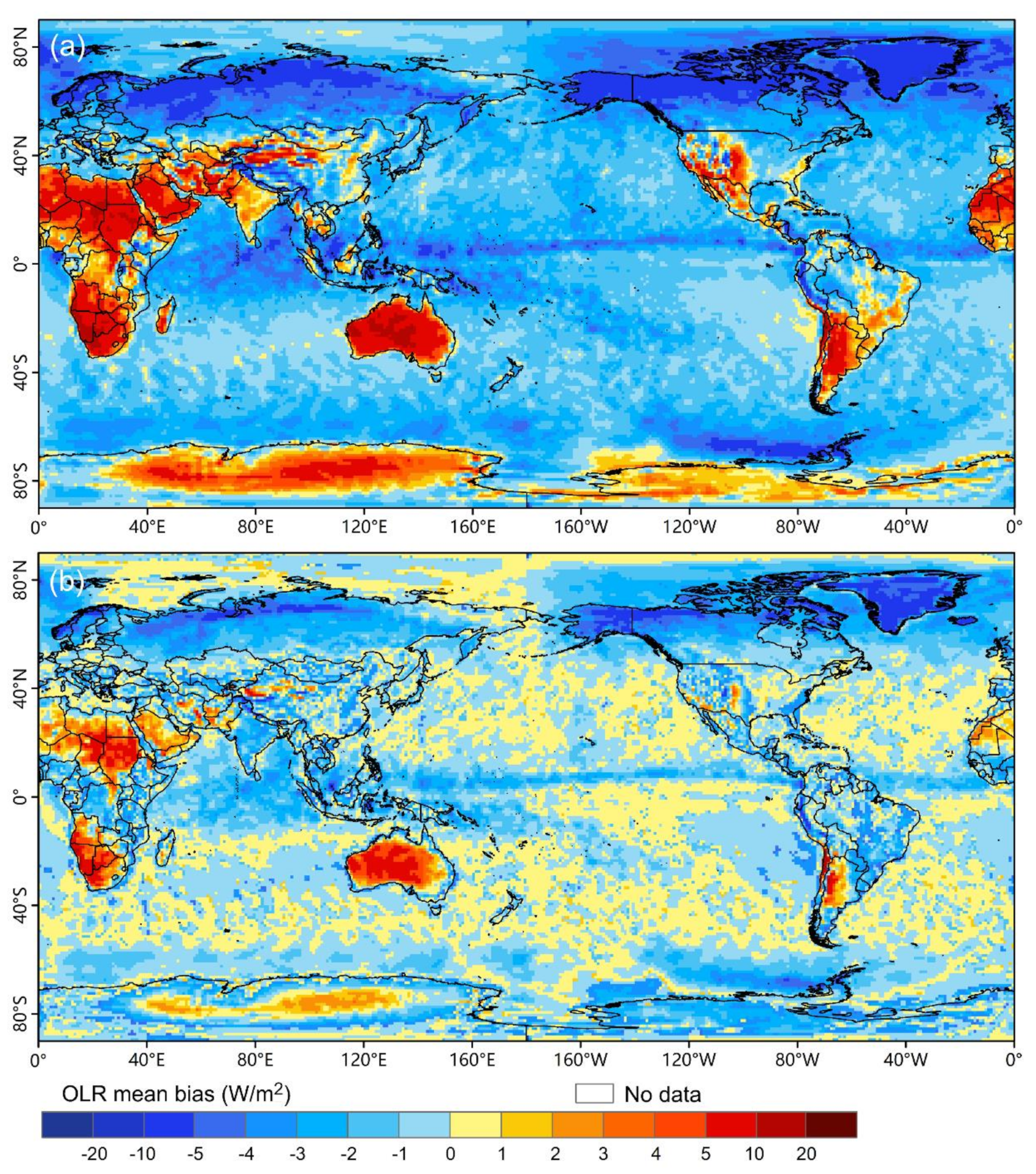
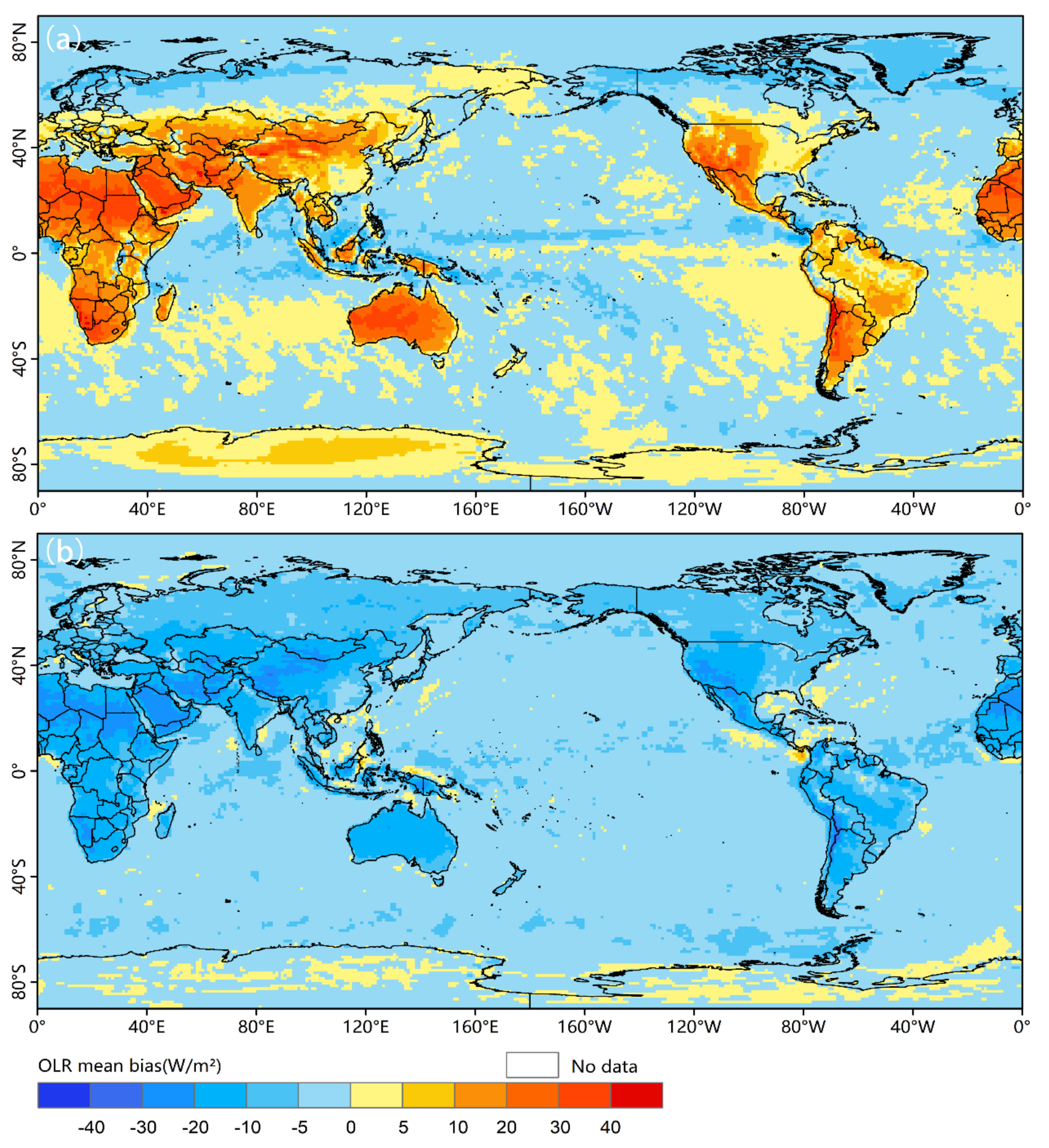
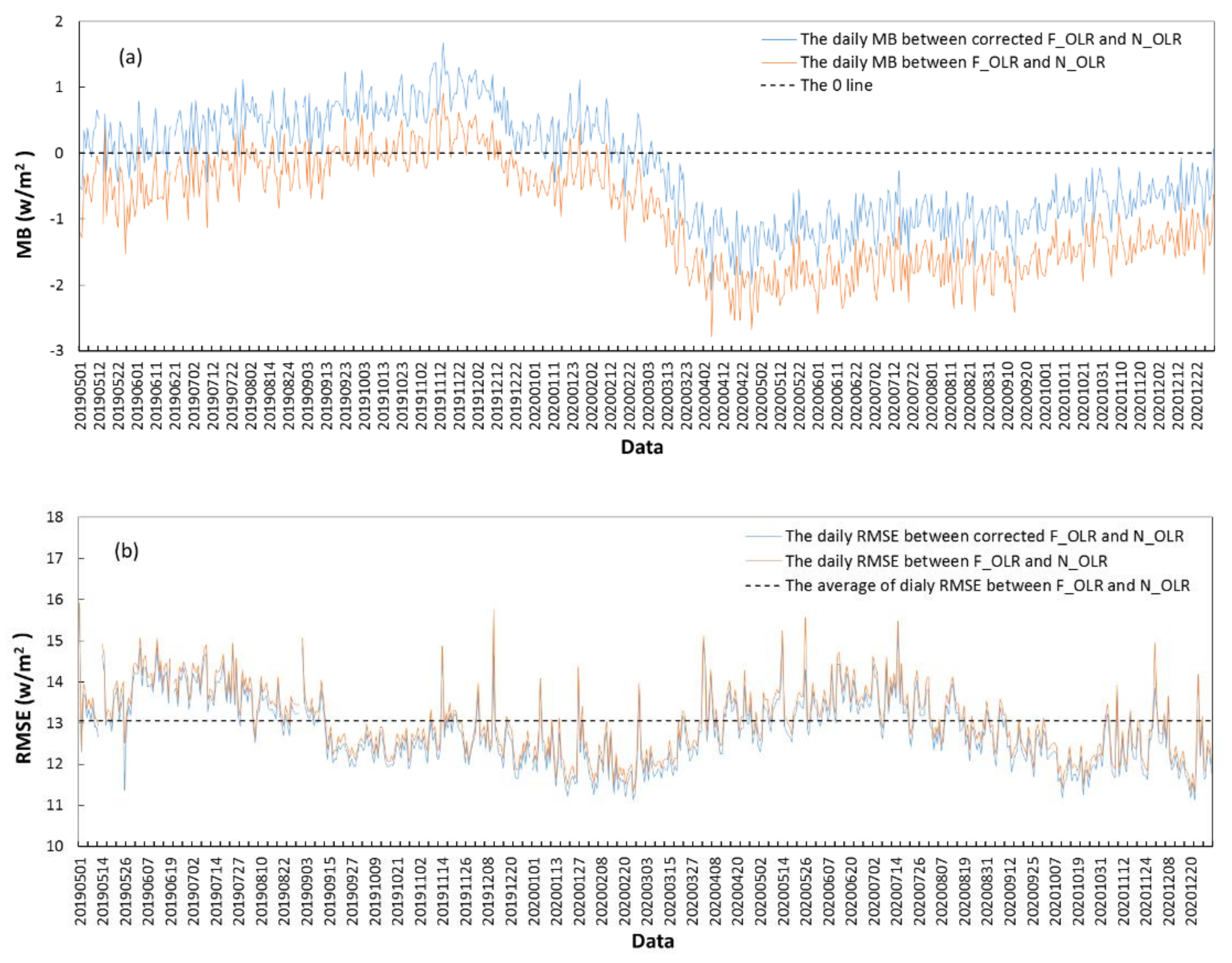

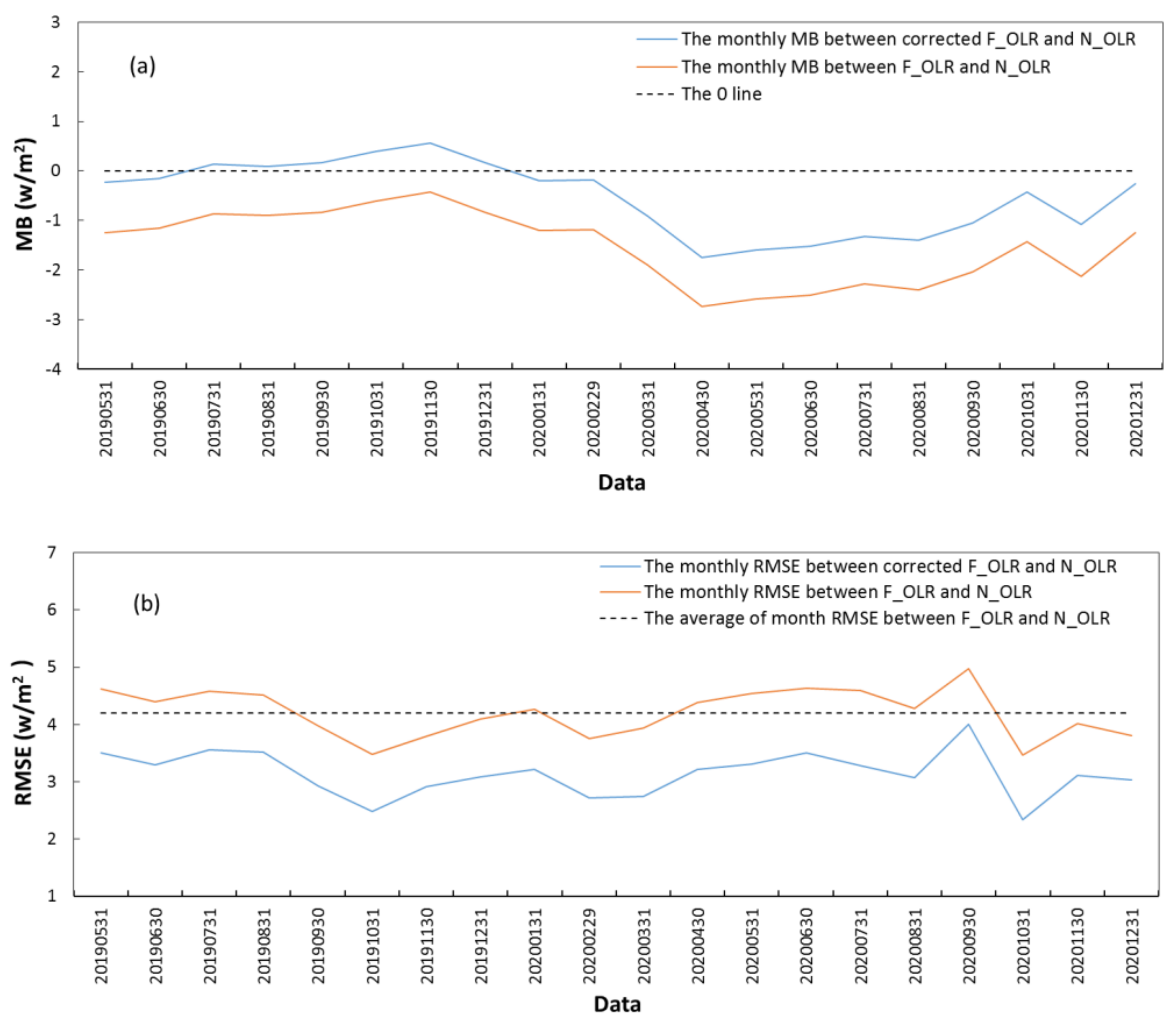

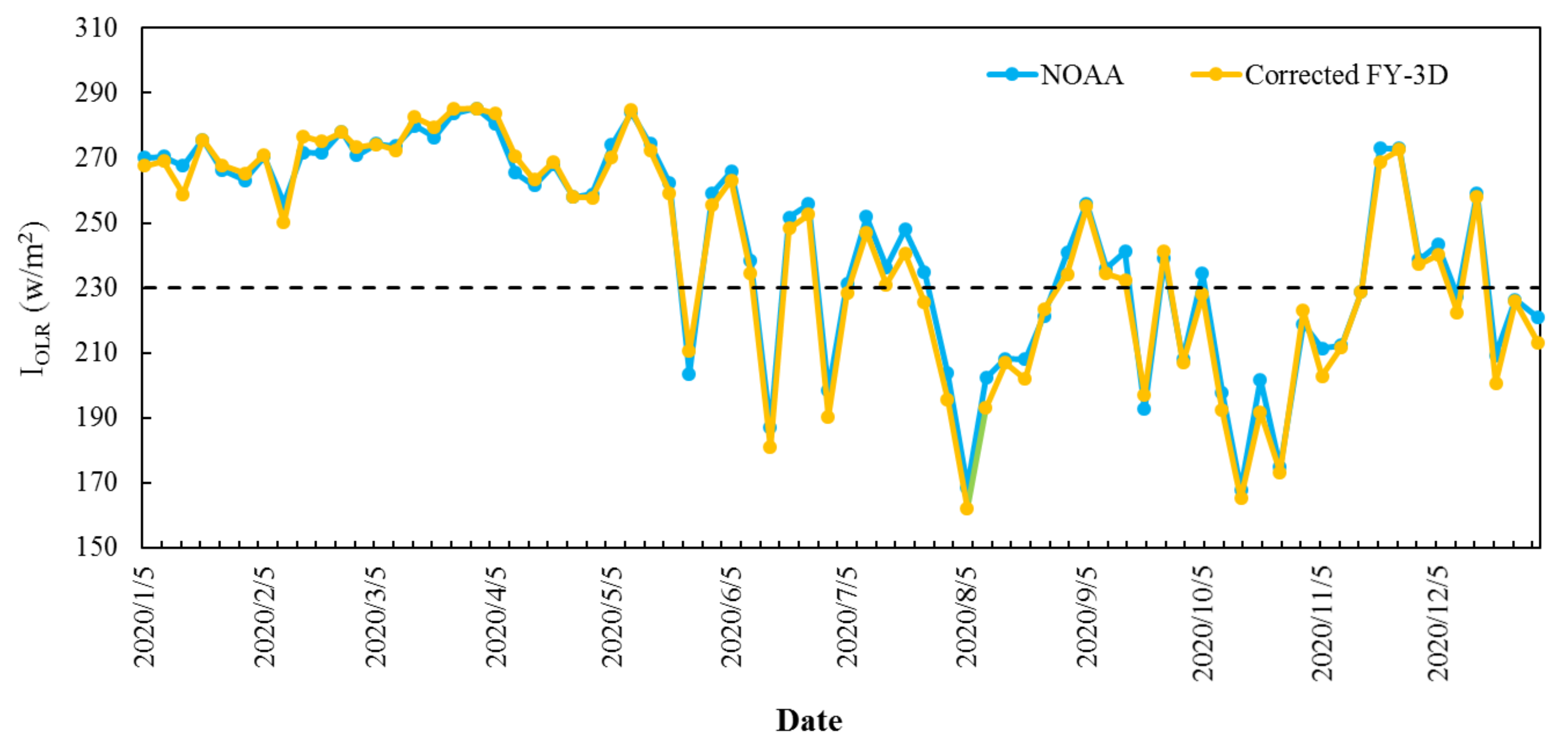
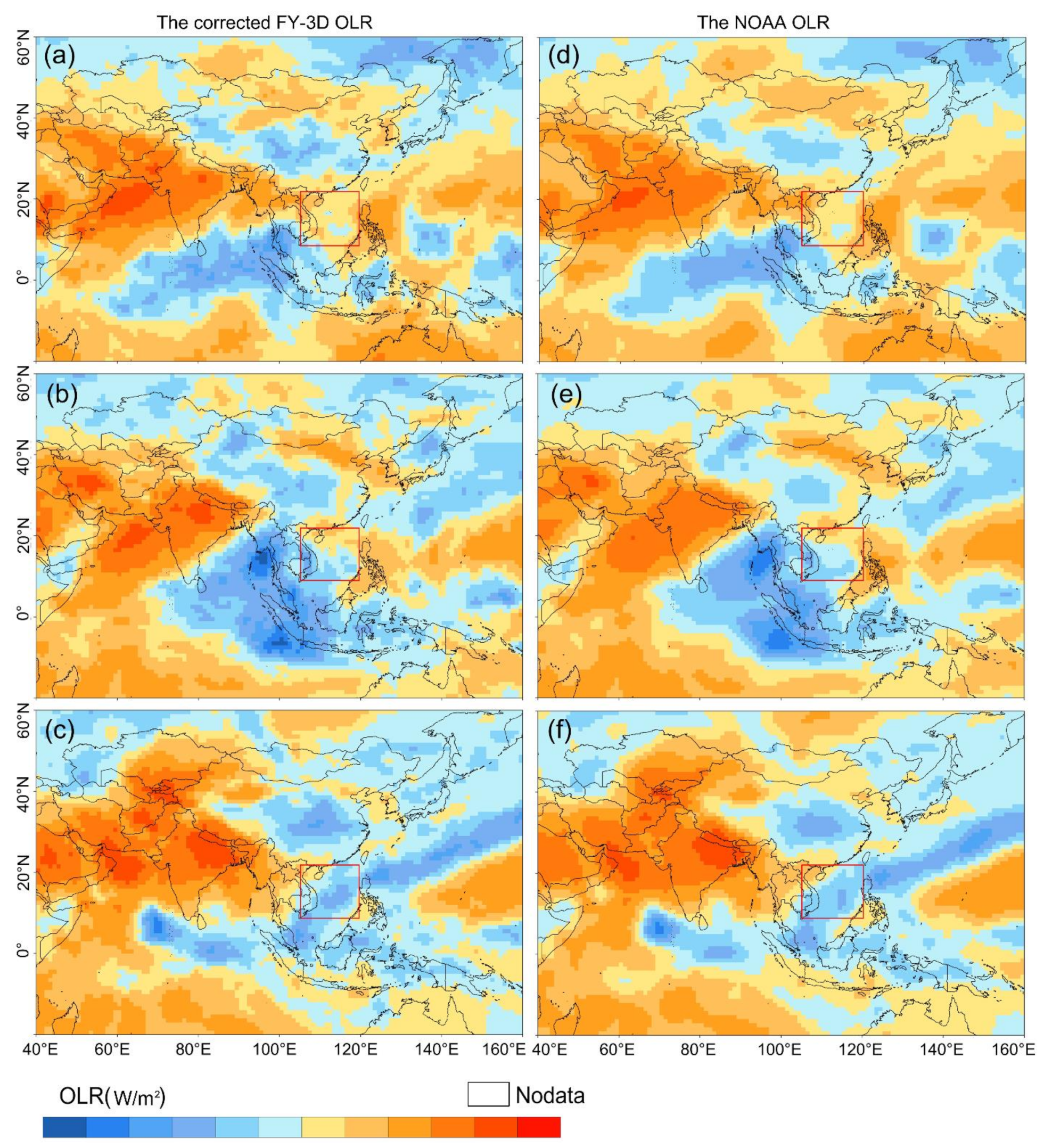
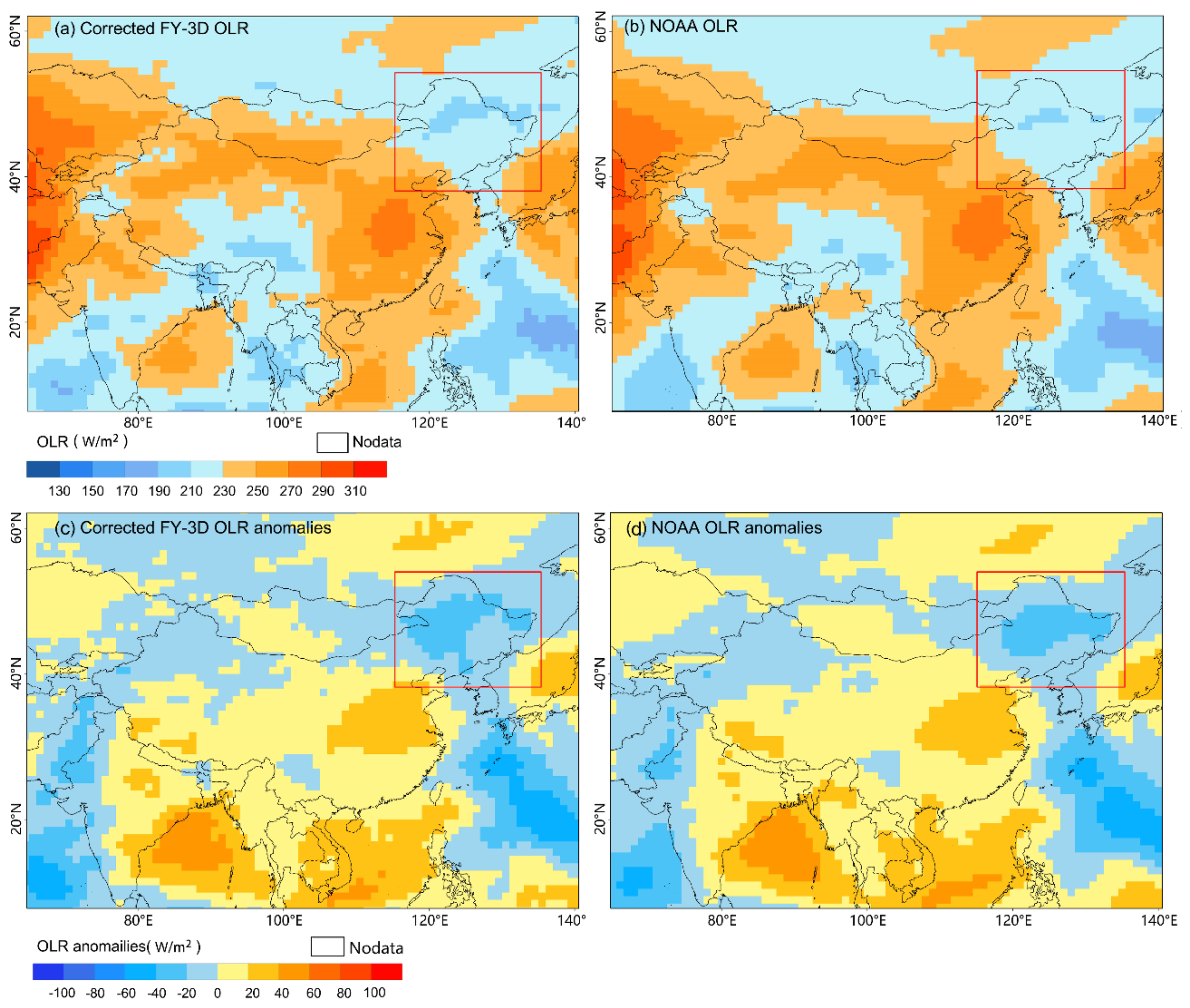
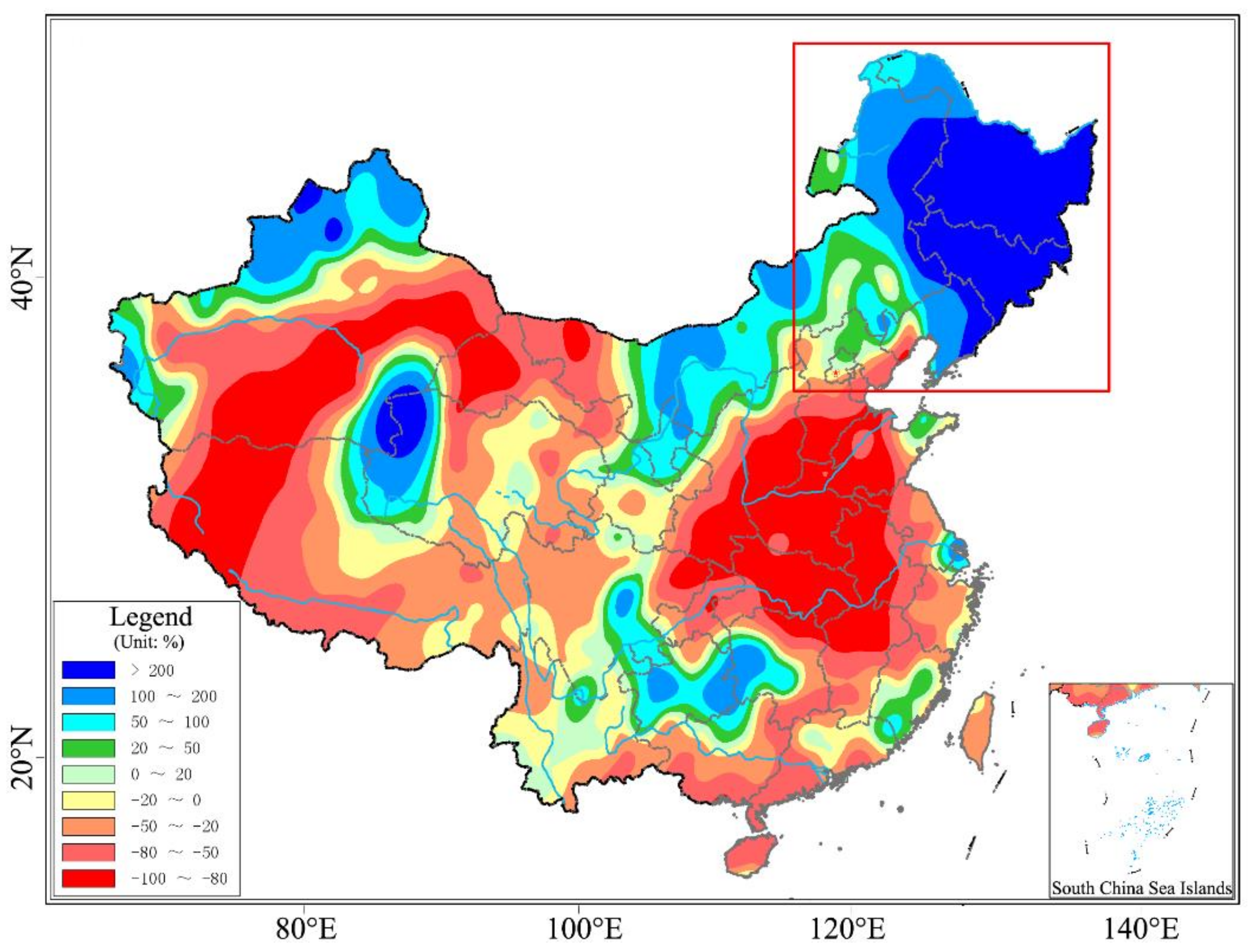
| N_OLR | F_OLR (Uncorrected) | F_OLR (Corrected) | |||||
|---|---|---|---|---|---|---|---|
| Date (May 2019–December 2020) | n | MB | RMSE | R | MB | RMSE | R |
| Day | 64,800 | −0.92 | 13.05 | 0.958 | −0.24 | 12.82 | 0.962 |
| Pentad | 64,800 | −1.33 | 6.54 | 0.984 | −0.43 | 5.76 | 0.991 |
| Month | 64,800 | −1.53 | 4.20 | 0.992 | −0.53 | 3.14 | 0.997 |
Publisher’s Note: MDPI stays neutral with regard to jurisdictional claims in published maps and institutional affiliations. |
© 2021 by the authors. Licensee MDPI, Basel, Switzerland. This article is an open access article distributed under the terms and conditions of the Creative Commons Attribution (CC BY) license (https://creativecommons.org/licenses/by/4.0/).
Share and Cite
Wang, Y.; Yan, F. Retrieval of Outgoing Longwave Radiation from the Fengyun-3D Satellite and Its Climate Applications. Remote Sens. 2021, 13, 3700. https://doi.org/10.3390/rs13183700
Wang Y, Yan F. Retrieval of Outgoing Longwave Radiation from the Fengyun-3D Satellite and Its Climate Applications. Remote Sensing. 2021; 13(18):3700. https://doi.org/10.3390/rs13183700
Chicago/Turabian StyleWang, Yanjiao, and Feng Yan. 2021. "Retrieval of Outgoing Longwave Radiation from the Fengyun-3D Satellite and Its Climate Applications" Remote Sensing 13, no. 18: 3700. https://doi.org/10.3390/rs13183700
APA StyleWang, Y., & Yan, F. (2021). Retrieval of Outgoing Longwave Radiation from the Fengyun-3D Satellite and Its Climate Applications. Remote Sensing, 13(18), 3700. https://doi.org/10.3390/rs13183700






